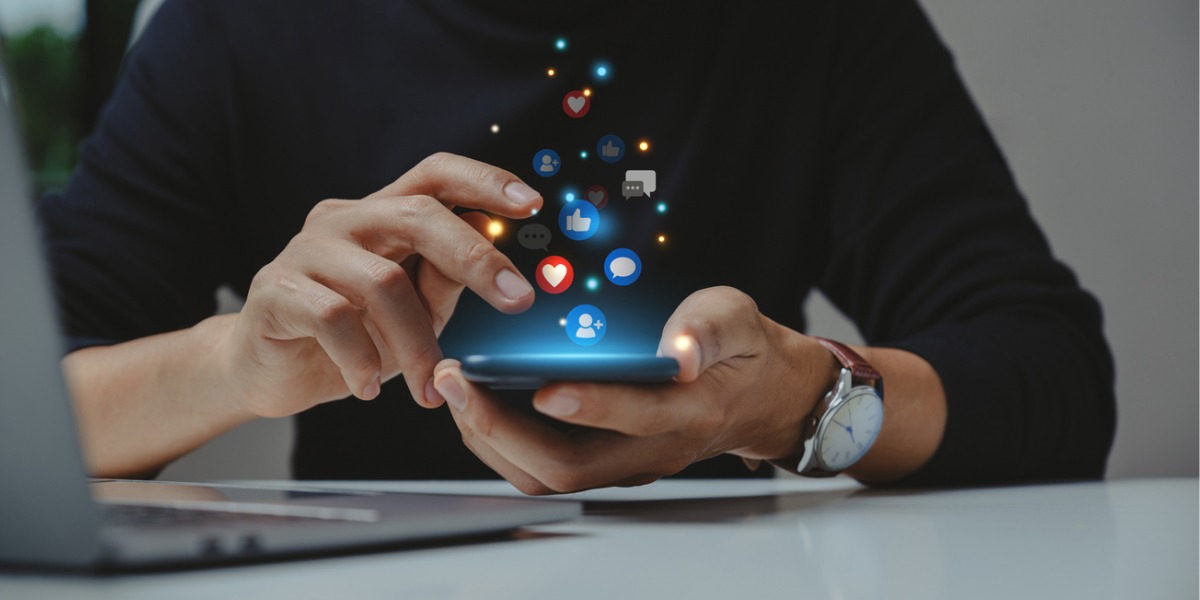In May 2023, U.S. Surgeon General Vivek Murthy released an advisory titled Social Media and Youth Mental Health. that included a summary of the most recent evidence on the relationship between social media use, anxiety, and depression. This document, which was based on a review of dozens of studies, meta analyses, and other published research, highlighted a broad range of concerns, including:
- Social media use is virtually ubiquitous among young people in the U.S. Studies show more than 95% of adolescents ages 13-17 use social media. Also, about 33% interact with social media sites or apps “almost constantly.”
- Risk for anxiety and depression increases up to 50% for young people who spend more than three hours per day on social media platforms.
- Over 40% of adolescents ages 13-17 said social media use makes them feel worse about their own bodies.
- Studies connect limiting social media use with decreases in anxiety and depression symptoms and improvements in overall life satisfaction.
- Researcher connects frequent social media use with a “modest yet statistically significant” increased risk of developing attention-deficit/hyperactivity disorder (ADHD).
The surgeon general’s advisory is just the latest in a series of studies and reports that have linked social media use with poor mental health.
Facebook Employee Testifies Before Congress
In 2021, former Facebook employee Frances Haugen revealed that the company’s internal studies indicated that Instagram had detrimental impact on the mental health of some young users, especially young girls. These findings, Haugen reported, included the following:
- 13.5% of teen girls in the UK said experience on Instagram exacerbated suicidal ideation.
- 17% of teen girls who said the intense symptoms of eating disorders increased after interacting with Instagram.
- 21% of teens in the U.S. said feelings of loneliness increased because of their Instagram use.
The majority of the headlines about social media use and mental health have focused on the harm that Instagram, Facebook, Twitter, TikTok, and other platforms can inflict. Several of these studies, such as the ones discussed by Frances Haugen, appear to establish a strong cause-effect relationship between using social media and struggling with various mental or emotional health concerns.
However, this doesn’t mean that all social media use is problematic from a mental health perspective. For example, the surgeon general’s advisory that we mentioned at the top of this page also included the following statistics:
- 58% of young social media users said the platforms help them feel more accepted.
- 71% said they appreciate having a place to exhibit their creativity.
- 80% said social media makes them feel more connected to their friends’ lives.
In recent years, researchers have begun to explore another potential benefit of social media use. They now analyze online behaviors in an attempt to predict risk for developing anxiety, depression, and other mental health disorders.
Can Instagram Use Predict Depression?
In August 2017, the journal EPJ Data Science published a study that explored the use of machine learning to identify signs of depression from Instagram photos. The authors of this study were Andrew G. Reece of Harvard University and Christopher M. Danforth of the University of Vermont.
Reece and Danforth used technology to assess 43,950 photos from 166 Instagram users. Among the subjects whose photos were included in this study, 71 had a history of depression and 95 did not.
Information Assessed by Algorithm
- Number of comments and likes that the photo received
- Number of human faces in the photo
- Photo’s position on the light spectrum (lower hue values skew toward the red end of the spectrum, while higher values place the photo closer to the blue end)
- Saturation level
- Brightness of the image
- If an Instagram filter had been used on the photo
Algorithm Review: Findings
- Photos taken by individuals with depression were more likely to be blue, darker, and less saturated.
- People with depression were more likely to post photos that feature people, but the average number of people in their photos was lower than among the non-depressed group.
- People with depression were less likely to use Instagram filters.
- Among the photographers who used filters, members of the depressed group were more likely to convert color photos to black and white, while non-depressed photographers were more likely to lighten the tint of their photos.
Algorithm Review: Researcher’s Conclusions
- Instagram user behaviors can be used to identify “markers of depression.”
- Depression markers can be detected in photos that were posted before the photographer was diagnosed with depression.
Reece and Danforth compared their results with previous studies that tested the ability of general practitioners to diagnose depression without using scales, questionnaires, or other tools.
They found that more than 50 percent of GP’s diagnoses turned out to be false, while the algorithm correctly identified depression in the majority of cases.
“Paired with a commensurate focus on upholding data privacy and ethical analytics, the present work may serve as a blueprint for effective mental health screening in an increasingly digitalized society,” the researchers wrote. “More generally, these findings support the notion that major changes in individual psychology are transmitted in social media use, and can be identified via computational methods.”
Can Twitter Reveal Anxiety?
In an effort that is similar to Reece and Danforth’s research, a team of experts from the University of São Paulo (Brazil) have recently been using artificial intelligence to analyze Twitter posts for evidence of anxiety and depression among users.
As described in an April 2023 News Wise article, the Brazilian research team has created a database of 3,900 Twitter users who had been diagnosed with anxiety, depression, or another mental health concern. The database includes both the contents of the users’ Tweets and information about the users’ connections with others on the platform.
The researchers found that the most successful approach involved an artificial intelligence model that was based on a machine learning algorithm called BERT (bidirectional encoder representations from transformers). The BERT model, which can analyze both certain word sequences as well as entire sentences, showed a “statistically significant” ability to identify signs of anxiety and depression via Tweets when compared to other machine learning models.
Examples of Twitter behaviors that are common among people with depression, the researchers found, included:
- Greater use of first-person singular pronouns (I and me)
- More frequent use of the heart emoji
- More likely to write about subjects that they had a personal connection to
- More likely to write about crises, psychology, and death
- Interactions with mental health forums and influencers who have discussed their mental health struggles
The research team intends to use the insights they gained from this study to develop an upgraded model that they hope can improve clinicians’ ability to identify and treat people who have anxiety disorders and depressive disorders.
“The signs of depression that can be detected during a visit to the doctor aren’t necessarily the same as the ones that appear on social media,” the study’s lead author, Ivandre Paraboni, said in the News Wise article.
How Will This Impact Mental Health Care?
The use of artificial intelligence and machine learning to identify signs of anxiety and depression has the potential to make a significant impact on the state of mental health treatment in the United States.
Anxiety disorders and depressive disorders are two of the most prevalent mental health concerns in the nation – yet many people who need help are not getting the care that could improve their lives.
Anxiety and Depression: The Treatment Gap
- Lifetime prevalence of anxiety disorders among U.S. adults and adolescents is about 30%.
- Past-year rate of major depression is 4% among U.S. adults and 17% among adolescents.
- Only about 47% of adults and 51% of adolescents with mental illnesses are receiving treatment.
Experts have long believed that early detection and increased time in treatment can improve outcomes for people with mental illness. In this context, the use of technology to identify people at risk appears to be promising.
However, we must weigh the potential benefits of using technology to spot signs of mental illness against a host of concerns and possible drawbacks.
Social Media and Detecting Anxiety and Depression: Issues to Resolve
- To date, research involving social media posts as diagnostic tools includes only anonymized data from willing participants. How will this technology perform in a less controlled environment?
- What are the ethical implications of applying predictive technology to flag people who may have mental illnesses? Who would have final say over the criteria that indicates a person has anxiety or depression?
- Who would inform the individual?
- How would they inform them?
- Who else would have access to this information?
- Who’s responsible for inaccurate diagnoses?
- Who’s responsible/accountable when technology fails to detect signs of mental illness in people with mental illness?
Artificial intelligence and other technological advances now play an expanded role in many aspects of modern life. It seems inevitable they’ll become part of process for screening, diagnosing, and treating mental illness.
The speed with which this occurs, the ways in which these developments are implemented, and – most importantly – how well they are able to help people who are in crisis remain to be seen.


 Gianna Melendez
Gianna Melendez Jodie Dahl, CpHT
Jodie Dahl, CpHT